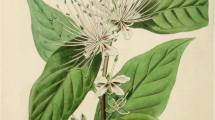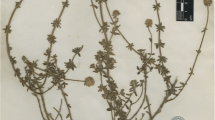Abstract
In this paper, the genusPinguicula is revised in the Iberian Peninsula. The taxa studied areP. vulgaris, P. nevadensis, P. grandiflora subsp.grandiflora, P. dertosensis, P. vallisneriifolia, P. longifolia subsp.longifolia, P. mundi, P. alpina andP. lusitanica. Five taxa are endemic to the area studied (P. nevadensis, P. dertosensis, P. vallisneriifolia, P. longifolia subsp.longifolia andP. mundi). Two of them are confined to restricted areas:P. nevadensis is endemic to the Sierra Nevada (S Spain) andP. longifolia subsp.longifolia is endemic to the central Pyrenees (N Spain). Taxonomical, nomenclatural, morphological, chromosomal, biogeographical and ecological data are reported for each taxon. A new combination is proposed:Pinguicula Sect.Longifolia (Casper) G. Blanca, M. Ruíz-Rejón etR. Zamora.
Similar content being viewed by others
References
Aguilella A., Tirado J. &Villaescusa C. (1992): Consideraciones sobre el géneroPinguicula en la provincia de Castellón.Anales Jard. Bot. Madrid 50: 121.
Bolòs O. &Vigo J. (1983): Notes sobre taxonomia i nomenclatura de les plantes, II.Collect. Bot. (Barcelona) 14: 89–103.
Britton N.L. &Brown A. (1913):An illustrated flora of the Northern United States. Ed. 2. Charles Scribner’s sons, New York.
Cañigueral J. (1957): Una variedad dePinguicula grandiflora en los montes cercanos a Tortosa:Pinguicula grandiflora Lamk. var.dertosensis nova.Collect. Bot. (Barcelona) 5: 413–415.
Casper S.J. (1962): Revision der GattungPinguicula in Eurasien.Feddes Repert. 66: 1–148.
Casper S.J. (1963): Gedanken zur Gliederung der GattungPinguicula L.Bot. Jahrb. Syst. 82: 321–335.
Casper S.J. (1966): Monographie der GattungPinguicula L.Biblioth. Bot. 127/128: 1–209.
Casper S.J. (1972):Pinguicula L. In:Tutin T.G., Heywood V.H., Burges N.A., Moore D.M., Valentine D.H., Walters S.M. &Webb D.A. (eds.),Flora europaea 3, Cambridge University Press, Cambridge, pp. 294–296.
Contandriopoulos J. (1962): Recherches sur la flore endemique de la Corse et sur ses origines.Ann. Fac. Sci. Marseille 32: 1–354.
Coutinho A.X.P. (1939):Flora de Portugal. Ed. 2. Ailland, Alves & Cia, Lisboa.
Cueto M. (1989):Los recursos vegetales de las Sierras de María y Orce como base para la gestión de un espacio natural. Ph.D. thesis, Universidad de Granada, Granada.
Cueto M. &Blanca G. (1997):Flora del Parque Natural “Sierra de María-Los Vélez”. SAHN, Almería.
Doulat E. (1947): Recherches caryologiques sur quelques.Pinguicula. Compt. Rend. Acad. Sci. Paris 225: 354–356.
Falk D.A. &Holsinger K.E. (1991):Genetics and conservation of rare plants. Oxford University Press, New York.
García M.B. &Antor R.J. (1992): Variabilidad fenotípica de un endemismo localizado en islas ecológicas:Pinguicula longifolia subsp.longifolia (Lentibulariaceae).Pirineos 139: 97–104.
Givnish T.J. (1989): Ecology and evolution of carnivorous plants. In:Abrahamson W.G. (ed.),Plant-animal interactions, McGraw Hill, New York, pp. 243–290.
Herrera C., Zamora R., Benavente A., Luque P. &Nieto R. (1994): Pinguicula vallisneriifolia.Planes de Actuación de las Especies Vegetales Amenazadas. Agencia de Medio Ambiente, Sevilla.
Heslop-Harrison Y. (1978): Plantas carnívoras.Invest. Ci. 19: 56–66.
Hitchcock A.S. & Green M.L. (1929): Standard-species of Linnaean genera ofPhanerogamae (1753–1754). In:Int. Bot. Congr. Cambridge (England), 1930, Nomencl. Prop. Brit. Bot., pp. 111–199.
Jarvis C.E., Barrie F.R., Allan D.M. & Reveal, J.L. (1993) (eds): A list of Linnaean generic names and their types.Regnum Veg. 127: 1–100.
Juniper B.E., Robins R.J. &Joel D.M. (1989):The carnivorous plants. Academic Press, London et al.
Kondo K. (1969): Chromosome numbers of carnivorous plants.Bull. Torrey Bot. Club 96: 322–328.
Laane M.M. (1967): Chromosome numbers in the flora of eastern Finmark. II.Blyttia 25: 45–54.
Laane M.M. (1969): Further chromosome studies in Norwegian vascular plants.Blyttia 27: 5–17.
Linnaeus C. (1737):Flora lapponica. Salomonem Schouten, Amsterdam.
Löve A. &Kjellqvist E. (1974): Cytotaxonomy of spanish plants. IV. Dicotyledons:Caesalpinaceae-Asteraceae.Lagascalia 4: 153–211.
Löve A. &Löve D. (1944): Cytotaxonomical studies on boreal plants. III. Some new chromosome numbers of Scandinavian plants.Arkiv. Bot. 31A, 12: 1–22.
Löve A. &Löve D. (1948): Chromosome number of Northern plant species.Rept. Dept. Agric. Univ. Inst. Appl. Sci. (Iceland), Ser. B 3: 9–131.
Löve A. &Löve D. (1956): Cytotaxonomical conspectus of the Icelandic flora.Acta Horti Gothob. 20: 65–291.
Löve A. & Löve D. (1982): [Report]. In:Löve A. & Löve D. (eds.), IOPB Chromosome number reports LXXV,Taxon 31: 344–360.
Mateo G. &Crespo M.B. (1995):Flora abreviada de la Comunidad Valenciana. Ed. Gamma, Alicante.
Murín A. (1976): Index of chromosome numbers of Slovakian flora. Part 5.Acta Fac. Rerum Nat. Univ. Comenianae, Bot. 25: 1–18.
Murín A., Háberová I. &C. Žamsran C. (1980): Karyological studies of some species of the Mongolian flora.Folia Geobot. Phytotax. 15: 395–405.
Rivas Martínez S., Díaz T.E., Prieto J.A.F., Loidi J. &Penas A. (1984):Los Picos de Europa. Ed. Leonesas, León.
Schemske D.W., Husban B.C., Ruckelshaus M.H., Goodwillie C., Parker I.M. &Bishop J. (1994): Evaluating approaches to the conservation of rare and endangered plants.Ecology 75: 584–606.
Schotsman H.D. (1970): Contribution à la caryologie des angiospermes de la Sologne et du Val de Loire.Bull. Cent. Ètud. Rech. Sci. 8: 21–63.
Sennen F. (1936): Plantes d’Espagne. Diagnoses et comentaires. Troisième partie.Bol. Soc. Ibér. Ci. Nat. 35: 17–32.
Wood C.E. &Godfrey R.K. (1957):Pinguicula (Lentibulariaceae) in the southeastern United States.Rhodora 59: 217–230.
Zamora R., Jamilena M., Ruíz Rejón M. &Blanca G. (1996): Two new species of the carnivorous genusPinguicula (Lentibulariaceae) from Mediterranean habitats.Pl. Syst. Evol. 200: 41–60.
Author information
Authors and Affiliations
Rights and permissions
About this article
Cite this article
Blanca, G., Ruíz-Rejón, M. & Zamora, R. Taxonomic revision of the genusPinguicula L. in the Iberian Peninsula. Folia Geobot 34, 337–361 (1999). https://doi.org/10.1007/BF02912819
Received:
Revised:
Accepted:
Issue Date:
DOI: https://doi.org/10.1007/BF02912819




